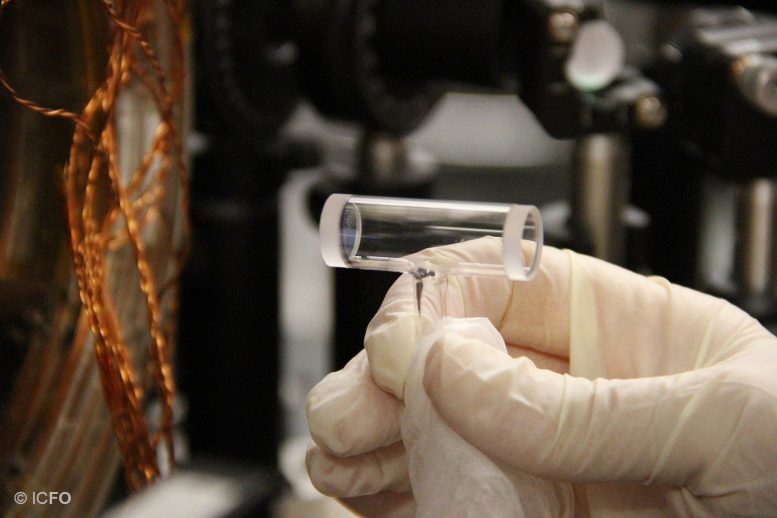Quantum entanglement is a process by which microscopic objects like electrons or atoms lose their individuality to become better coordinated with each other. Entanglement is at the heart of quantum technologies that promise large advances in computing, communications and sensing, for example detecting gravitational waves.
Entangled states are famously fragile: in most cases even a tiny disturbance will undo the entanglement. For this reason, current quantum technologies take great pains to isolate the microscopic systems they work with, and typically operate at temperatures close to absolute zero. The ICFO team, in contrast, heated a collection of atoms to 450 Kelvin, millions of times hotter than most atoms used for quantum technology. Moreover, the individual atoms were anything but isolated; they collided with each other every few microseconds, and each collision set their electrons spinning in random directions.
The researchers used a laser to monitor the magnetization of this hot, chaotic gas. The magnetization is caused by the spinning electrons in the atoms, and provides a way to study the effect of the collisions and to detect entanglement. What the researchers observed was an enormous number of entangled atoms — about 100 times more than ever before observed. They also saw that the entanglement is non-local — it involves atoms that are not close to each other. Between any two entangled atoms there are thousands of other atoms, many of which are entangled with still other atoms, in a giant, hot and messy entangled state.
Picture of the glass cell that where the rubidium metal is mixed with nitrogen gas and heated up to 450 degrees Kelvin. At that high temperature, the metal vaporizes, creating free rubidium atoms that diffuse around inside the cell. Credit: © ICFO
What they also saw, as Jia Kong, first author of the study, recalls, “is that if we stop the measurement, the entanglement remains for about 1 millisecond, which means that 1000 times per second a new batch of 15 trillion atoms is being entangled. And you must think that 1 ms is a very long time for the atoms, long enough for about fifty random collisions to occur. This clearly shows that the entanglement is not destroyed by these random events. This is maybe the most surprising result of the work.”
The observation of this hot and messy entangled state paves the way for ultra-sensitive magnetic field detection. For example, in magnetoencephalography (magnetic brain imaging), a new generation of sensors uses these same hot, high-density atomic gases to detect the magnetic fields produced by brain activity. The new results show that entanglement can improve the sensitivity of this technique, which has applications in fundamental brain science and neurosurgery.
As ICREA Prof. at ICFO Morgan Mitchell states, “this result is surprising, a real departure from what everyone expects of entanglement.” He adds “we hope that this kind of giant entangled state will lead to better sensor performance in applications ranging from brain imaging to self-driving cars to searches for dark matter.”
A Spin Singlet and QND
A spin singlet is one form of entanglement where the multiple particles’ spins–their intrinsic angular momentum–add up to 0, meaning the system has zero total angular momentum. In this study, the researchers applied quantum non-demolition (QND) measurement to extract the information of the spin of trillions of atoms. The technique passes laser photons with a specific energy through the gas of atoms. These photons with this precise energy do not excite the atoms but they themselves are affected by the encounter. The atoms’ spins act as magnets to rotate the polarization of the light. By measuring how much the photons’ polarization has changed after passing through the cloud, the researchers are able to determine the total spin of the gas of atoms.
The SERF regime
Current magnetometers operate in a regime that is called SERF, far away from the near absolute zero temperatures that researchers typically employ to study entangled atoms. In this regime, any atom experiences many random collisions with other neighboring atoms, making collisions the most important effect on the state of the atom. In addition, because they are in a hot medium rather than an ultracold one, the collisions rapidly randomize the spin of the electrons in any given atom. The experiment shows, surprisingly, that this kind of disturbance does not break the entangled states, it merely passes the entanglement from one atom to another.




No comments:
Post a Comment